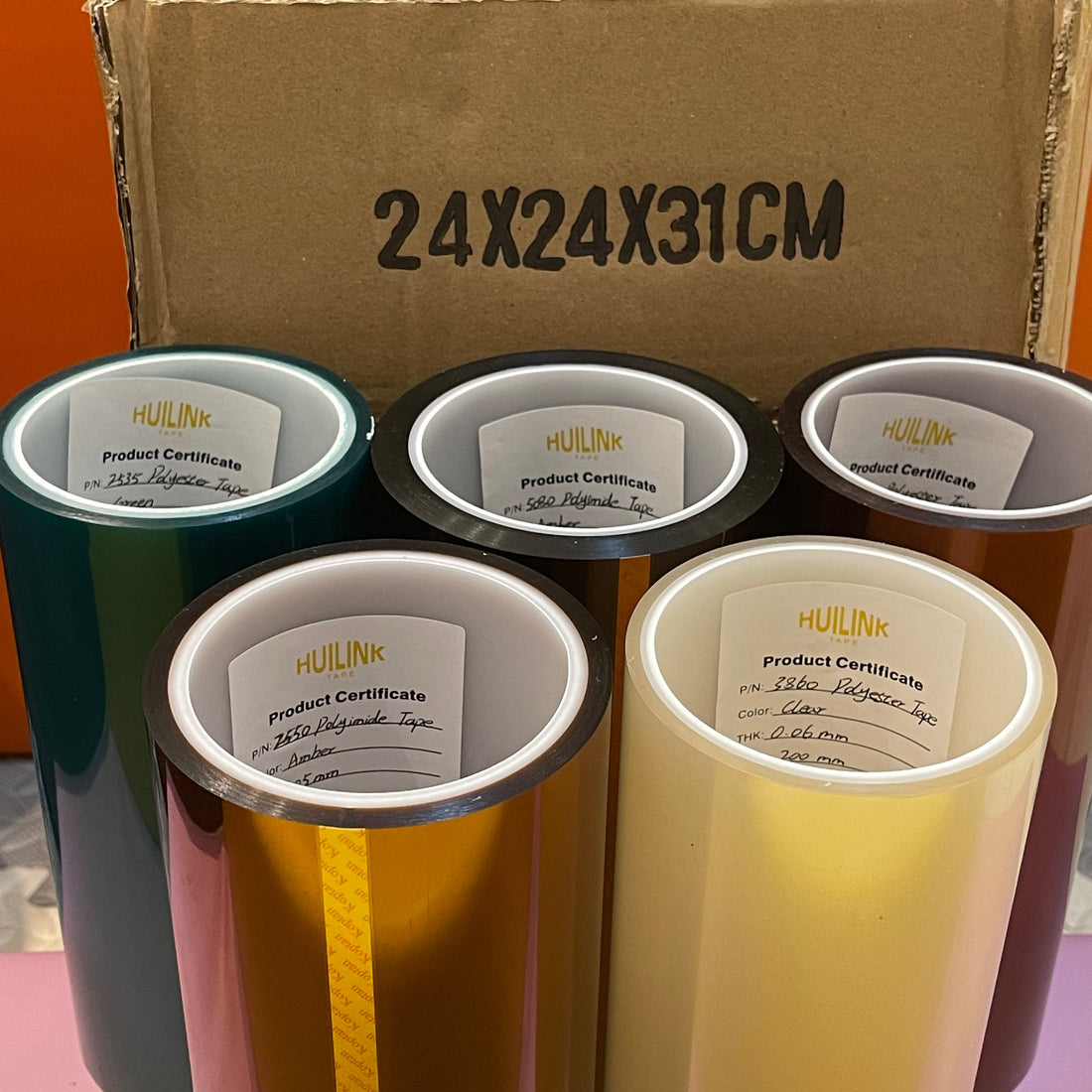
Polyimide vs Polyester Tape: Heat Resistance & Performance Comparison"
Share
In the fields of electronics manufacturing and industrial applications, Polyimide tape (PI, often called Kapton tape) and Polyester tape (PET tape) are two of the most common high-performance tapes. They may look similar, but their performance, application scenarios, and costs differ significantly. Making the wrong choice can lead to product failure, reduced production efficiency, or cost overruns.
This article will provide a detailed comparison of the performance characteristics of these two tapes, helping you make the smartest choice based on your specific needs.
Core Performance Comparison
To quickly understand the differences between them, here is a key performance comparison between polyimide tape and polyester tape:
| Feature | Polyimide Tape (PI/Kapton) | Polyester Tape (PET) |
|---|---|---|
| Long-Term Temp Resistance | -70℃ ~ +260℃ | 130℃ ~ 150℃ |
| Short-Term Temp Resistance | Up to 260℃ (30 minutes residue-free) | Up to 180℃ (approx. 30 minutes) |
| Typical Thickness | 0.025mm-0.15mm | 0.05mm-0.15mm |
| Dielectric Strength | 3700V (50μm) | Data N/A |
| Chemical Resistance | Excellent (resists acids, alkalis, solvents) | Good (resists general chemicals) |
| Mechanical Strength | High tensile strength, tear-resistant | Good, but lower than PI |
| Typical Color | Amber, Black | Clear, Amber, Green, Black |
| Cost-Effectiveness | Higher | Higher (Lower Cost) |
| Primary Applications | High-temp environments, precision electronics, aerospace | General electronics, packaging, labels |
In-Depth Analysis: When to Choose Which Tape?
Polyimide Tape (PI/Kapton Tape)
Polyimide tape uses polyimide film as the base material, coated with high-temperature resistant silicone pressure-sensitive adhesive. It is highly regarded for its exceptional high-temperature resistance and electrical insulation properties.
Key Features:
-
Extreme Temperature Resistance: This is the most significant advantage of PI tape. Its long-term use temperature range can reach -70℃ ~ +260℃, with even higher short-term tolerance. Makes it ideal for protecting PCB gold fingers during processes like wave soldering and reflow soldering.
-
Excellent Chemical Stability: Resists many chemicals such as acids, alkalis, and solvents, suitable for environments potentially exposed to chemicals.
-
Superior Electrical Properties: Features high dielectric strength (e.g., tesa® 67350 reaches 3700V and insulation, reliable for high-voltage and high-frequency environments.
-
High Mechanical Performance & Stability: Possesses high tensile strength and tear resistance, and remains dimensionally stable at high temperatures, resistant to shrinkage or deformation.
Typical Application Scenarios:
-
PCB Boards: Protecting gold fingers during solder masking to prevent solder adhesion.
-
High-Temperature Electrical Insulation: Insulation wrapping for transformers and motor coils.
-
Lithium Battery Manufacturing: Used for cell fixation and insulation (e.g., edge wrapping).
-
Aerospace Avionics: Applications requiring endurance of extreme temperature changes.
Polyester Tape (PET Tape)
Polyester tape uses polyester film (PET) as the base material, coated with acrylic or silicone adhesive. It offers a good balance between cost-effectiveness and overall performance.
Key Features:
-
Good Temperature Resistance: Long-term heat resistance typically 130℃ ~ 150℃ (acrylic adhesive) or 150℃ ~ 180℃ (silicone adhesive), short-term up to 180℃ or 220℃. Meets the needs of most conventional electronics manufacturing.
-
Excellent Electrical Insulation: Provides good electrical insulation protection, suitable for many electronic components.
-
High Transparency & Flexibility: Clear PET tape allows for viewing of adhered objects and is flexible, making it easy to handle.
-
Outstanding Cost-Effectiveness: Significantly cheaper than polyimide tape, making it very suitable for cost-sensitive applications with moderate temperature requirements.
Typical Application Scenarios:
-
Electronic Component Manufacturing: Temporary PCB protection, insulation, and fixation of electronic components.
-
Packaging & Labeling: Can be used for label materials requiring some heat resistance.
-
Light Bundling & Masking: Wire harness bundling, light component fixation, and masking protection at medium temperatures.
How to Choose Based on Your Needs?
Prioritize Polyimide Tape (PI) if:
-
The operating temperature consistently exceeds 150℃, or short-term exposure to temperatures above 260℃ (e.g., soldering processes) is required.
-
The application environment involves strong acids, alkalis, or strong solvents.
-
There are extremely high requirements for electrical insulation performance (e.g., high-voltage environments).
-
The application is in extreme environments like aerospace or near automotive engines.
-
The budget is relatively ample, and performance priority is higher than cost.
Prioritize Polyester Tape (PET) if:
-
The operating temperature is typically below 150℃.
-
It's used for general electronic circuit board insulation protection without exposure to very high-temperature processes.
-
Cost is an important consideration, and raw material expenses need to be controlled1.
-
The application is for packaging, labeling, or temporary fixation where extreme durability is not required.
--------------------------------------------------------------------------------------
-
"High temperature PI tape"
-
"PCB gold finger protection tape"
-
"260°C high temperature insulation tape"
-
"Lithium battery insulation tape"
-
"Polyimide Kapton tape price"
-
"PET insulation tape"
-
"Economical heat-resistant tape"
-
"Electronic component protection tape"
-
"Polyester film tape"
-
"PI tape vs PET tape difference"
-
"How to choose high temperature tape"
-
"Which tape for gold finger protection"
-
"Polyimide tape alternative"